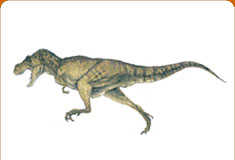
After many millions of years of evolution, nature arrived at T. rex, an almost perfect killing machine. It was capable of running at great speed to catch other dinosaurs (or anything it wanted to eat). It had large feet to help it run quickly through the swampy environment in which it lived, maybe as fast as 35 mph. Although it had very short arms, they were very strong. But it didn't need its arms to be an effective and efficient killer. It had enormous strength in its jaws; it could bite right through the frill of a Triceratops or into the back of a hadrosaur. In fact, the only thing that a T. rex had to fear was another T. rex. Most of the scars and wounds found on fossil bones of these great creatures seem to come from others of its kind.
T. rex is very well known, with more than 30 individual specimens having been found. Less than half of these had any significant amount of the fossil, but it still gives us a very good picture of these creatures. The most famous of the fossils of this creature is "Sue" which is now on display at the Field Museum in Chicago. Sue is about 42 feet long; her largest tooth is almost 12 inches.
T. rex is a good example of how our thinking about dinosaurs has changed based on how much we have learned. Back in 1915 when the first skeleton was mounted, most people thought it was a slow beast that dragged its tail along the ground. This view was partially because it would have been very expensive to mount it any other way, and scientists weren't sure how it looked in life. Now, scientists are confident that they understand how T. rex and other dinosaurs looked and lived. T. rex probably walked and ran with its back and tail parallel to the ground, its massive legs and hips a fulcrum for its body. It was an active beast, and recent evidence strongly suggests it was warm blooded.
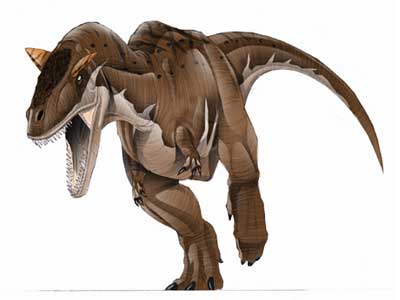
Discovered fairly recently (1985), this fossil was very complete and included the best theropod skin impressions ever found. The skin showed many small cone-shaped nodules, each about two inches (5 cm) across, regularly spaced over its body. Carnotaurus had a short snout for a larger theropod. Its skull measured only 22 inches. Its arms were so small that it almost appears that the hands sprouted right from its body.
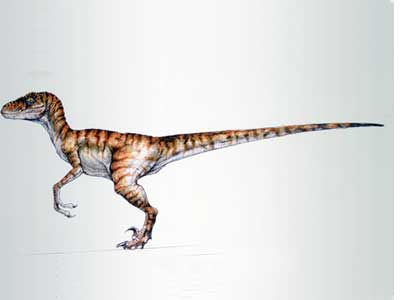
Since the movie "Jurassic Park", Velociraptor has become the most famous dinosaur, even more so than T. rex. What is interesting is that it doesn't really look like the movie dinosaur. Velociraptor is much smaller than in the film and it has a longer, thinner snout. Still, pound for pound, Velociraptor was a very effective killing machine!
One of the most unique aspects of Velociraptor is the "Killing Claw" it has on each foot. Each inside toe has a large (about 5 inches) hooked claw that is controlled by a strong tendon. This claw is held upward when the animal is walking or running. However, when it attacks, the tendon snaps tight and the claw snaps down with great speed and force, slicing deeply into the victim. Not a very pretty picture, but an effective way to inflict a serious wound.
Velociraptor was probably a pack hunter, which would have allowed it to attack prey much larger than itself. It also had a very large brain relative to its size - it was one of the smartest dinosaurs. It was very light and very fast. Recent thinking is that it was also very close to being birdlike, and that it had feathers that it used both for display and insulation. It had very strong arms and claws, which were effective weapons by themselves. It had sharp, recurved teeth in its long mouth. One of the most fascinating fossil discoveries ever made is of a Velociraptor locked in mortal combat with a Protoceratops. Both creatures probably died instantly in a sandstorm and their bodies were buried with the claws of the raptor in the body of the little ceratopsian, whose mouth was firmly locked on the raptors leg.
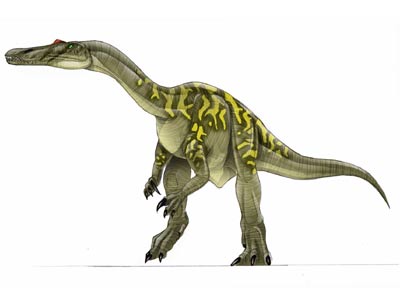
The body and back legs of Baryonyx are similar to other theropod dinosaurs, but from there it gets a little peculiar. The arms were long and powerfully built. They had three fingers, one with an enormous claw. The skull was long and low with twice as many teeth - 128 - as most other theropods. Even more strangely, the nasal openings were located on top of its head, just in front of the eyes. It had teeth similar to Spinosaurus, long and conical with small serrations, which was also very unlike most theropods. Baryonyx's neck was long and relatively slender. It is no accident that its skull and teeth are very similar to those of a crocodile as they probably both had a diet consisting primarily of fish. Imagine them as huge reptilian grizzly bears, fishing with those terrible foot long claws.
Scientists are still studying the curiosities this dinosaur presents. It seems to combine some very primitive characteristics with more advanced dinosaurian design. As the only known specimen seems to have been a sub-adult, the upper limits of its size are still theoretical.
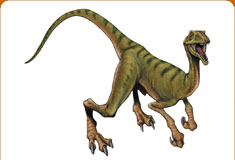
Compsognathus is one of those dinosaurs around which some controversy swirls. Some paleontologists feel that, like the much larger Tyrannosaurus, the little Compsognathus had only two fingers. Others feel strongly that it had three. Since there are only two known fossils, and the bones are not perfectly preserved in an articulated (as they were in life) manner, it may take more discoveries to solve this issue.
Compsognathus is considered an important link in the study of bird evolution. The original fossil of this dinosaur was found in the same place as Archeopteryx, the early feathered reptile. Compsognathus shares a number of characteristics with this creature, but Compsognathus did not appear to have feathers. This is one of those interesting dinosaurs where scientists hope to find more specimens to learn the answers to many questions.
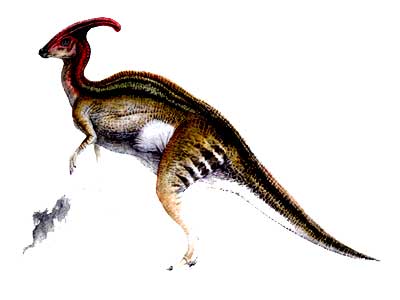
Parasaurolophus would have walked primarily on all four legs, but it could have stood on its hind legs to feed or defend itself and used its long tail for balance. It had a fairly long neck that would have allowed it to find food on the ground or in trees. It was a member of family of dinosaurs we refer to as duckbills, meaning it had a hard beak in the front of its mouth and hundreds of teeth in the back for chewing tough plant material. These types of plant-eaters were most likely easy prey for the large predators of this time, so it probably found safety in numbers.
The long tube that makes up the crest is connected to the nostrils and the back of the throat of this dinosaur. It may have been able to make very loud sounds that could have been heard for miles.
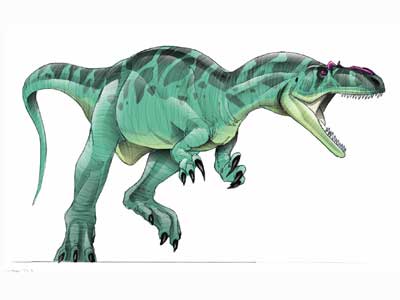
Allosaurus lived among some of the largest dinosaurs to ever walk the earth and it is likely that it hunted some of smaller members of these families. Even the smaller members would have been huge, and this required Allosaurus to have great strength.
Allosaurus is the namesake of the very successful allosaurid family of dinosaurs. This family includes what may be the very largest carnivore, the Giganotosaurus, and other creatures such as the Acrocanthosaurus and Carcharodontosaurus. Its more distant relatives are the raptors and tyrannosaurs of the late Cretaceous.
Allosaurus had relatively small teeth for such a large dinosaur, especially when compared to later big carnivores. It probably had a weak bite compared to its size, but its mouth could open very wide. Allosaurus most likely used its very heavily muscled arms with its huge claws as potent weapons in bringing down and holding its prey. It also was close to having true stereo vision - its big eyes had some forward vision that would have allowed for a degree of depth perception.
There is a great deal known about this dinosaur's life style. Footprint evidence indicates it hunted in groups and that it cared for its young in large nests. It inhabited floodplains, meadows and some forests.
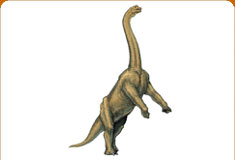
It is possible that some specimens of Brachiosaurus reached heights exceeding 50 feet and weighed as much as 80 tons; in fact, it may never have stopped growing as long as it lived, which may have been over 100 years! It had, like other typical sauropods, peg-like teeth in a head that seemed very small for such a large creature. Studies about how much these creatures needed to eat and how such a small head could ingest enough food to fuel such a large body have concluded that a full grown Brachiosaurus would have needed to eat 440 pounds (200 kg) of food every day - if it was warm-blooded as many scientists believe. Some scientists have stated that these huge, small-headed creatures would have needed to eat every waking moment in order to provide enough food to keep such a large body alive. Brachiosaurus, like other sauropods, seemed to have every adaptation needed for continuous eating, including having nostrils on the top of its head, so breathing would not interfere with eating.
In order to facilitate the processing of food, which it could not chew with its teeth, Brachiosaurus swallowed stones that the dinosaur kept in its gizzard similar to that found in a chicken. The tough plant fibers would spend time in the gizzard stewing and being ground up by the stones. It probably traveled in herds, the sheer size of the adults protecting the young from predators. This creature is known from two fairly complete skeletons, one of which is on display in Berlin, Germany and the other in Chicago, USA.
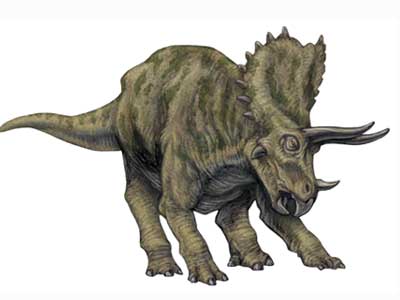
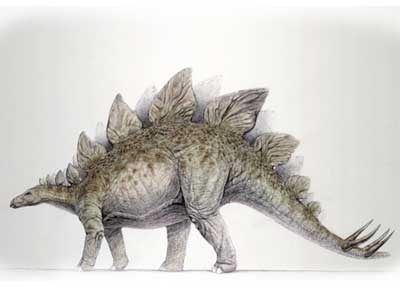
Stegosaurus is often called the dumbest dinosaur because of its incredibly small brain. In fact, most scientists believe that its brain was too small to control such a large creature and that it used an auxiliary "brain" located above its rear legs to help control its movements. This was not actually a brain, but a bundle of nerves that helped relay information from its real brain.
Most fascinating to people are the plates along its back. There has been a great deal of debate about their use and arrangement. The plates were up to 2-feet tall and 2-feet wide (.6 m). The most prevalent theory is that they were used for cooling or heating the animal. A more recent theory, however, suggests that they could have been used as a display during courtship and that they may have been brightly colored. It is also possible that they could move up and down, perhaps to intimidate predators.
The spikes on its tail are also the subjects of some controversy. For years every model of Stegosaurus showed it with the spikes sticking up into the air. It is only since the 1990's that it has become accepted that these spikes stuck out horizontal to the ground, which would have been a potent defensive weapon when swung at a hunter.
Stegosaurus would have lived in family groups and possibly herds, moving slowly through forests while eating the low-growing plants. Its front legs were considerably shorter than its hind legs, making it adapted to nibbling the plants closest to the ground. Stegosaurus is the namesake for a large family of dinosaurs whose members were found all over the world.
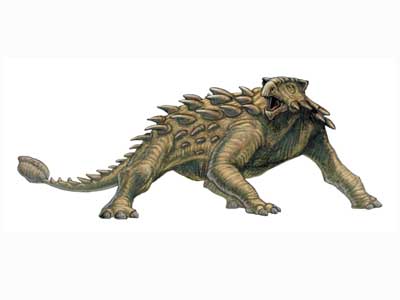
As a defensive creature, Ankylosaurus was one of nature's most perfect designs. It was almost impervious to being bitten from above and its long, strong tail muscles would have been able to swing its club with great force.
There is very little fossil material from this dinosaur - it was apparently the last and largest of this family of armored dinosaurs. It walked fairly upright on all four legs, carrying its tail off the ground and it is theorized that it would drop to the ground when attacked to use its armor as a shield to cover its legs and under belly.

With its small, toothless head, it is believed that Gallimimus probably had a diet of insects, small animals, eggs and maybe even some plants. They hand very long fingers and long arms, which they could use for digging or grabbing eggs. They had a much longer neck that any other therapod dinosaur. In Jurassic Park they were shown as large flock, but we don't know if that was real or movie behavior.
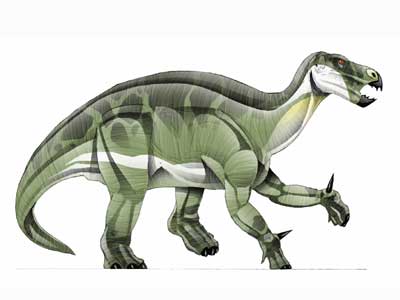
Iguanodon has become quite famous as a result of its starring role in Dinosaur, but before that it helped people understand what dinosaurs really looked like. It was one of the first complete skeletons ever found. This allowed scientists who had never seen a complete dinosaur, to figure out what it would have looked like in life. In fact, the first time this common dinosaur was found as just a partial skeleton, scientists put its thumb spike on its nose!
This was only the second dinosaur to be described, after Megalosaurus. Its teeth were discovered in the early 1820's in England - these original fossils were "rediscovered" in the British Museum in 1977. As nothing like it had ever been described in scientific literature, the teeth of this creature were a puzzle that an amateur paleontologist named Gideon Mantell solved by comparing them to the teeth of living animals. Mantell found that the teeth looked like those of a modern iguana and named it Iguanodon. He speculated that it was a huge extinct version of this modern reptile. It was in 1878 in a coal mine in Belgium that 24 fairly complete and articulated specimens were found. Although they were of a larger species, they clearly showed what this creature looked like in life.
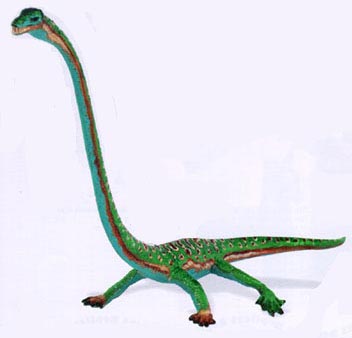
At Dinosaur World, Tanystropheus is blue, which would be an appropriate color for an animal living in the water, but, as always, the color is just a guess. Another guess made about the colors of prehistoric animals--illustrated by this portrayal of Tanystropheus--is that, like modern animals, they most likely were lighter colored underneath. Such a color scheme, which has no basis in observable facts about the fossils, makes the appearance of the animals more convincing.
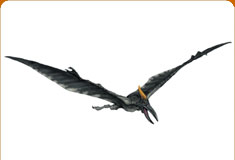
Members of the pterosaur family lived through much of the Mesozoic, some with wingspans close to 50 feet. Pteranodon, as you can tell by the translation of its name, had no teeth. It probably used the long crest on the back of its head to help it steer while flying. There is still some debate about whether these reptiles could actually fly or if they were primarily gliders, but the consensus seems to be that they could take off with little or no wind.
Their diet was probably fish and scavenged remains of dead animals. Quite a few Pteranodon skeletons have been found in Kansas in the central part of the U.S. This would have been the shore of a shallow sea when these creatures were alive, supporting the theory that they were fish eaters.
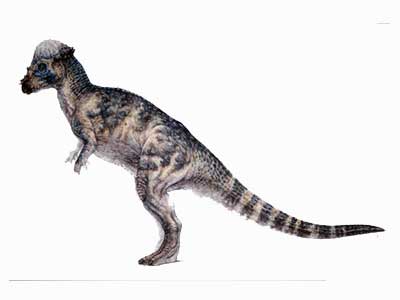
A skeleton of the Pachycephalosaurus has never been found, so most of what is known about it is only from the skull and its close relatives. There are several strange characteristics, in addition to its thick skull. It lived at the very end of the dinosaur age, when most dinosaurs were fairly advanced, yet it still had five fingers, a primitive characteristic. Also, the shape of its teeth was somewhat primitive, similar to those of the Stegosaurus which had lived over 100 million years earlier. These were clearly plant-eater teeth, but it also had front teeth that could have been used like a meat-eater.
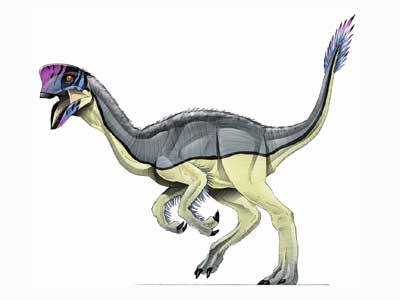
Oviraptor is a very unique dinosaur with some rather strange features. Instead of teeth it has a beak and something not seen in any other dinosaur, two teeth in the roof of its mouth. The reason it got its name is that when it was first discovered Oviraptor was sitting on a nest of eggs. It was thought it was stealing the eggs of another dinosaur. Years later, it was found that the eggs were its own and that it was trying to protect them from an approaching sandstorm.
Oviraptor has another unusual feature - it has a thin crest of bone on its forehead. This crest seems to have grown and changed throughout its entire life. It may have been used as a form of individual identification or to differentiate gender. Also, different species of the Oviraptor genus had different crests. It is not clear what Oviraptor ate. Since it was probably not eggs, and it had very strong jaws, some think it would have eaten shellfish that it could easily crack open. Others argue that it must have been an herbivore as its skull did not show characteristics for meat-eating.
Of particular note is that an as yet undescribed North American Oviraptor was discovered in 1996 in South Dakota. This specimen is very large, almost 20 feet long. A trackway has also been associated with this find.